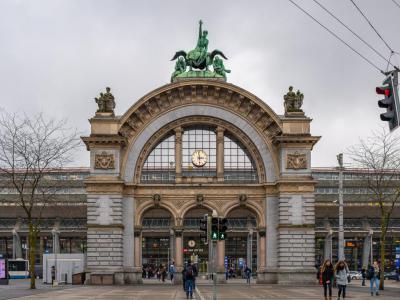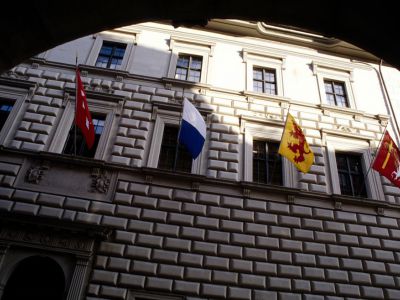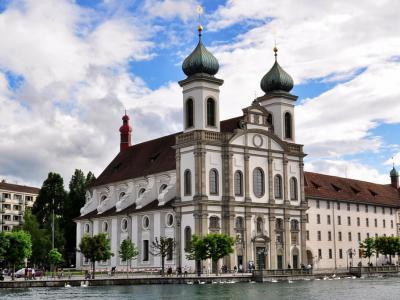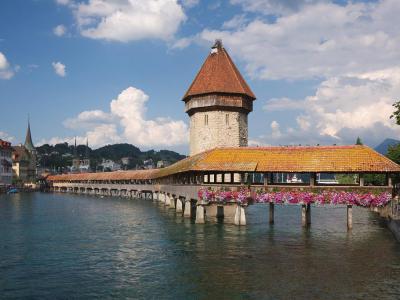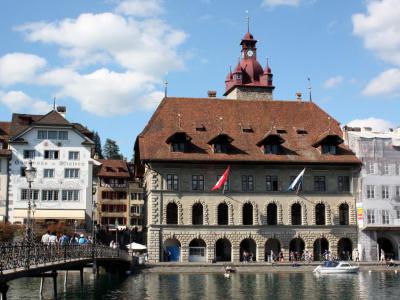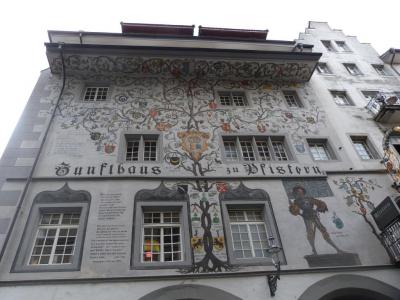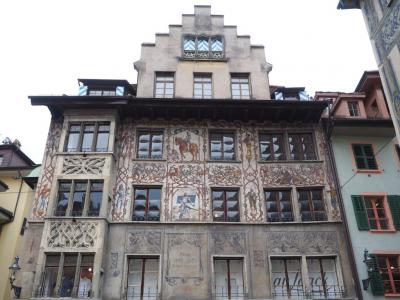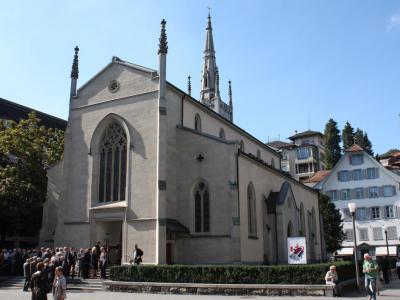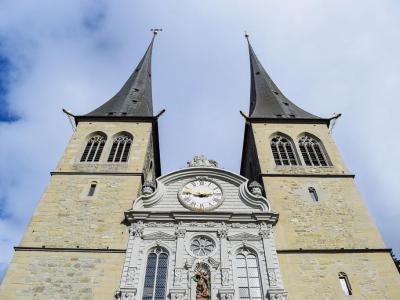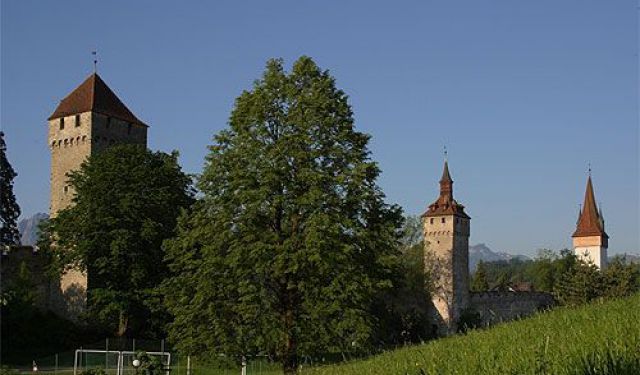
Lucerne's Architectural Jewels Walking Tour (Self Guided), Lucerne
Lucerne's long religious and cultural history is duly reflected in its architecture, making it one of the most popular tourist destinations in Switzerland. There are quite a few places in the city that need not strive for attention and can easily catch the eye of any passer-by. Such like are:
The Lucerne Railway Station – an architectural jewel and main hub of the Swiss railway network, built in 1896; renowned for its entrance hall with a distinctive cupola and elegant curved roof.
Ritter Palace – early Renaissance, Florentine-style piece of architecture; seat of the cantonal government.
Rathaus (the Town Hall) – one of the most beautiful historical buildings in Lucerne; completed in 1606.
Zunfthaus zu Pfistern (Pfistern Guild Hall) – formerly Guild Hall, now a restaurant serving Swiss cuisine.
Dornach House – a charming neo-Gothic edifice with Mannerist fresco paintings. Built around 1900, dedicated to the Swiss victory in the Battle of Dornach.
Straddling the river Reuss, Lucerne boasts several remarkable bridges, such as the Chapel Bridge – the oldest covered bridge in Europe, dated 1333 – symbol of the city and one of Switzerland's best known landmarks.
Your attention will also be struck by the number of magnificent churches, including:
Jesuit Church (Jesuitenkirche) – the first large Baroque temple in Switzerland; consecrated in 1677.
St. Matthew Church (Matthäuskirche) – a fascinating piece of Gothic Renaissance architecture; German composer Richard Wagner married here for the second time in 1870.
Church of St. Leodegar – named after the city's patron saint; sitting atop a small hill above the lake front. Originally built in 735, redesigned in Renaissance style in 1639.
If you wish to acquaint yourself more closely with the architectural jewels of Lucerne, consider taking our self-guided walking tour.
The Lucerne Railway Station – an architectural jewel and main hub of the Swiss railway network, built in 1896; renowned for its entrance hall with a distinctive cupola and elegant curved roof.
Ritter Palace – early Renaissance, Florentine-style piece of architecture; seat of the cantonal government.
Rathaus (the Town Hall) – one of the most beautiful historical buildings in Lucerne; completed in 1606.
Zunfthaus zu Pfistern (Pfistern Guild Hall) – formerly Guild Hall, now a restaurant serving Swiss cuisine.
Dornach House – a charming neo-Gothic edifice with Mannerist fresco paintings. Built around 1900, dedicated to the Swiss victory in the Battle of Dornach.
Straddling the river Reuss, Lucerne boasts several remarkable bridges, such as the Chapel Bridge – the oldest covered bridge in Europe, dated 1333 – symbol of the city and one of Switzerland's best known landmarks.
Your attention will also be struck by the number of magnificent churches, including:
Jesuit Church (Jesuitenkirche) – the first large Baroque temple in Switzerland; consecrated in 1677.
St. Matthew Church (Matthäuskirche) – a fascinating piece of Gothic Renaissance architecture; German composer Richard Wagner married here for the second time in 1870.
Church of St. Leodegar – named after the city's patron saint; sitting atop a small hill above the lake front. Originally built in 735, redesigned in Renaissance style in 1639.
If you wish to acquaint yourself more closely with the architectural jewels of Lucerne, consider taking our self-guided walking tour.
How it works: Download the app "GPSmyCity: Walks in 1K+ Cities" from Apple App Store or Google Play Store to your mobile phone or tablet. The app turns your mobile device into a personal tour guide and its built-in GPS navigation functions guide you from one tour stop to next. The app works offline, so no data plan is needed when traveling abroad.
Lucerne's Architectural Jewels Walking Tour Map
Guide Name: Lucerne's Architectural Jewels Walking Tour
Guide Location: Switzerland » Lucerne (See other walking tours in Lucerne)
Guide Type: Self-guided Walking Tour (Sightseeing)
# of Attractions: 9
Tour Duration: 2 Hour(s)
Travel Distance: 2.3 Km or 1.4 Miles
Author: doris
Sight(s) Featured in This Guide:
Guide Location: Switzerland » Lucerne (See other walking tours in Lucerne)
Guide Type: Self-guided Walking Tour (Sightseeing)
# of Attractions: 9
Tour Duration: 2 Hour(s)
Travel Distance: 2.3 Km or 1.4 Miles
Author: doris
Sight(s) Featured in This Guide:
- Lucerne Railway Station
- Ritter Palace
- Jesuit Church (Jesuitenkirche)
- Chapel Bridge
- Rathaus (Town Hall)
- Zunfthaus zu Pfistern (Pfistern Guild Hall)
- Dornach House
- St. Matthew Church (Matthäuskirche)
- Church of St. Leodegar
1) Lucerne Railway Station (must see)
The Lucerne Railway Station is the main hub of Switzerland's rail network. It serves domestic and international traffic on several rail lines. The station is located in a waterfront location on the south side of Lake Lucerne just above the outflow of the Reuss river. A square occupies the area between the front of the station and the lakefront, and is heavily used by the local buses. The landing stages used by the passenger ships are located at the lakeside of the square, providing interchange between rail and water transport. An underground shopping mall lies below both the concourse of the railway station and the square.
The station building was built in 1896. It featured an amazing entrance hall with a distinctive cupola and an elegant curved roof. A fire broke out in 1971 and destroyed much of the building including the cupola, the station frontage and concourse.
A new station was eventually built, and opened on 5 February 1991, exactly 20 years after its predecessor was destroyed. The historic entrance portal facing the lake was re-erected to honor the legacy 1896 building. The portal is crowned by a sculpture named "Zeitgeist" by the well known Swiss sculptor, Richard Kissling.
The station building was built in 1896. It featured an amazing entrance hall with a distinctive cupola and an elegant curved roof. A fire broke out in 1971 and destroyed much of the building including the cupola, the station frontage and concourse.
A new station was eventually built, and opened on 5 February 1991, exactly 20 years after its predecessor was destroyed. The historic entrance portal facing the lake was re-erected to honor the legacy 1896 building. The portal is crowned by a sculpture named "Zeitgeist" by the well known Swiss sculptor, Richard Kissling.
2) Ritter Palace
Perhaps the most impressive Renaissance palace in Lucerne's Old Town, the Ritterscher Palace began as a private residence, commissioned in 1556 by Mayor Lux (Lucius) Ritter. The former mercenary and rich landowner, Ritter sought to emphasize his social status by building a Renaissance palazzo in the Florentine style, featuring heavy blocks and nice masonry, which had already been practiced in Florence for 100 years, but still new in Lucerne.
Hired for the job was a widely famous Italian stonemason Giovanni Lynzo, aka Hans of Trient. Initially reluctant, he was engaged but eventually, during the work, was found guilty of heresy and beheaded. Legend has it that on the day of his execution the architect accursed Lux Ritter who, coincidence or not, died a few days later.
The construction of the three-storey palace with an open courtyard was completed by that time only by about two-thirds. Since the heirs of Lux Ritter were not able to continue, the project was taken over by the city council of Lucerne, who finished the building and in 1578 handed it over to the newly arrived Jesuits.
Today, alongside history devotees, art lovers take particular interest in Jakob von Will’s Danse Macabre ("Dance of Death") painted series adorning the top floor corridor – made up of seven pictures with 23 scenes depicting various social classes being confronted with death.
The striking edifice is also the seat of the Cantonal Administration, whose offices are located in the spectacular inner courtyard featuring a three-story loggia with Tuscan columns. So please be quiet!
NOTE: generally open to the public during office hours, Monday to Friday, the building can be closed anytime for governmental events or state receptions. The admission is free.
Hired for the job was a widely famous Italian stonemason Giovanni Lynzo, aka Hans of Trient. Initially reluctant, he was engaged but eventually, during the work, was found guilty of heresy and beheaded. Legend has it that on the day of his execution the architect accursed Lux Ritter who, coincidence or not, died a few days later.
The construction of the three-storey palace with an open courtyard was completed by that time only by about two-thirds. Since the heirs of Lux Ritter were not able to continue, the project was taken over by the city council of Lucerne, who finished the building and in 1578 handed it over to the newly arrived Jesuits.
Today, alongside history devotees, art lovers take particular interest in Jakob von Will’s Danse Macabre ("Dance of Death") painted series adorning the top floor corridor – made up of seven pictures with 23 scenes depicting various social classes being confronted with death.
The striking edifice is also the seat of the Cantonal Administration, whose offices are located in the spectacular inner courtyard featuring a three-story loggia with Tuscan columns. So please be quiet!
NOTE: generally open to the public during office hours, Monday to Friday, the building can be closed anytime for governmental events or state receptions. The admission is free.
3) Jesuit Church (Jesuitenkirche) (must see)
The Lucerne Jesuit Church, located in Lucerne, is a prominent Catholic place of worship. It holds the distinction of being the first grand Baroque-style church constructed in northern Switzerland, situated above the Alps.
The Jesuit order, initiated by Ignatius of Loyola in 1534, played an active role in the Counter-Reformation, which was the Catholic response to the emergence of Protestantism. Protestant reformers like Zwingli in Zurich and Calvin in Geneva had caused a religious divide in predominantly Catholic Switzerland. In response to this situation, the Lucerne city council invited the Jesuits to establish a college in the year 1573.
Ludwig Pfyffer, who held the position of mayor in Lucerne, provided annual financial support to the Jesuits from his personal resources. The Jesuit College of Lucerne was officially founded in 1577, and it was housed in the Ritter Palace, a building originally constructed in 1557 to serve as the residence of Mayor Lux Ritter.
The construction of the associated church commenced in 1667, and by 1673, the basic structure of the church, including its main façade, had been completed. The church was consecrated in 1677, although the interior was not fully finished at that time. Numerous side altars were still missing, and even the high altar wasn't erected until four years later due to financial difficulties. The iconic onion-domed towers were not finished until 1893. In the mid-18th century, the vault underwent a redecoration. The original vestments of Brother Klaus, a renowned Swiss patron, are housed in the inner chapel.
Today, while the church presents an aesthetically pleasing exterior along the river promenade, its remarkable and unaltered pink and white interior truly captivates visitors. Entry to the church is free, and upon stepping inside, you will encounter one of the most magnificent churches in all of Switzerland.
The Jesuit order, initiated by Ignatius of Loyola in 1534, played an active role in the Counter-Reformation, which was the Catholic response to the emergence of Protestantism. Protestant reformers like Zwingli in Zurich and Calvin in Geneva had caused a religious divide in predominantly Catholic Switzerland. In response to this situation, the Lucerne city council invited the Jesuits to establish a college in the year 1573.
Ludwig Pfyffer, who held the position of mayor in Lucerne, provided annual financial support to the Jesuits from his personal resources. The Jesuit College of Lucerne was officially founded in 1577, and it was housed in the Ritter Palace, a building originally constructed in 1557 to serve as the residence of Mayor Lux Ritter.
The construction of the associated church commenced in 1667, and by 1673, the basic structure of the church, including its main façade, had been completed. The church was consecrated in 1677, although the interior was not fully finished at that time. Numerous side altars were still missing, and even the high altar wasn't erected until four years later due to financial difficulties. The iconic onion-domed towers were not finished until 1893. In the mid-18th century, the vault underwent a redecoration. The original vestments of Brother Klaus, a renowned Swiss patron, are housed in the inner chapel.
Today, while the church presents an aesthetically pleasing exterior along the river promenade, its remarkable and unaltered pink and white interior truly captivates visitors. Entry to the church is free, and upon stepping inside, you will encounter one of the most magnificent churches in all of Switzerland.
4) Chapel Bridge (must see)
The Chapel Bridge is a wooden foot bridge that stretches diagonally across the Reuss River in Lucerne. It got its name from Saint Peter's Chapel nearby. What makes this bridge special is that it has some old paintings inside from the 17th century. Unfortunately, many of these paintings were destroyed in a fire that happened in 1993, which also damaged most of the bridge. Thankfully, they fixed it up afterward. This bridge is not just any bridge; it's actually the oldest covered wooden bridge in Europe and the world's oldest surviving truss bridge. People in Lucerne really like it, and it's a famous tourist spot in Switzerland.
Originally, they built this bridge in 1333 as part of Lucerne's defenses. It connected the old town on one side of the river to the new town on the other side, which helped protect the city from attacks coming from the south of Lake Lucerne. At first, it was more than 200 meters long, but over time, they made it shorter and did some work on the riverbanks, so now it's 170 meters long.
Lucerne is special because it has three wooden pedestrian bridges: the Hof Bridge from the 14th century (but that one's gone now), the Chapel Bridge, and the Spreuer Bridge from the 16th century. All of them have paintings on the inside in triangle-shaped frames. No other wooden footbridges in Europe have this. The paintings on the Chapel Bridge were made in the 17th century by a local Catholic painter named Hans Heinrich Wagmann. They show things from Lucerne's history. There used to be 147 paintings on the bridge before the fire in 1993, but they could only fully restore 30 of them.
Tip:
Experience it at night with the city lights, swans, flowers and romantic atmosphere. Both banks are full of great shopping and fantastic restaurants.
Originally, they built this bridge in 1333 as part of Lucerne's defenses. It connected the old town on one side of the river to the new town on the other side, which helped protect the city from attacks coming from the south of Lake Lucerne. At first, it was more than 200 meters long, but over time, they made it shorter and did some work on the riverbanks, so now it's 170 meters long.
Lucerne is special because it has three wooden pedestrian bridges: the Hof Bridge from the 14th century (but that one's gone now), the Chapel Bridge, and the Spreuer Bridge from the 16th century. All of them have paintings on the inside in triangle-shaped frames. No other wooden footbridges in Europe have this. The paintings on the Chapel Bridge were made in the 17th century by a local Catholic painter named Hans Heinrich Wagmann. They show things from Lucerne's history. There used to be 147 paintings on the bridge before the fire in 1993, but they could only fully restore 30 of them.
Tip:
Experience it at night with the city lights, swans, flowers and romantic atmosphere. Both banks are full of great shopping and fantastic restaurants.
5) Rathaus (Town Hall)
The Lucerne Town Hall, known as Rathaus, is an Italian Renaissance style building that is considered by many to be one of the most beautiful historical buildings in Lucerne. Construction began on Rathaus in 1602 and was completed in 1606. It was designed by architect Anton Isenmann.
Rathaus is located in the heart of Old Town. Its location on the River Reuss offers perfect photo ops for visitors who want a great view of the Chapel Bridge. This is particularly true on Tuesdays and Saturdays from 6 AM to 1 PM when market stalls open and tourists can partake in shopping while admiring the architecture.
Inside the building, visitors will find an exhibit hall and a concert hall. They may view the paintings and coffered ceilings from long ago as they find their way to the dovecote. Located in the Rathaus attic, the dovecote lets visitors both watch and feed the birds. They can even enjoy an exhibit that details the history of the Rathaus doves.
Rathaus is located in the heart of Old Town. Its location on the River Reuss offers perfect photo ops for visitors who want a great view of the Chapel Bridge. This is particularly true on Tuesdays and Saturdays from 6 AM to 1 PM when market stalls open and tourists can partake in shopping while admiring the architecture.
Inside the building, visitors will find an exhibit hall and a concert hall. They may view the paintings and coffered ceilings from long ago as they find their way to the dovecote. Located in the Rathaus attic, the dovecote lets visitors both watch and feed the birds. They can even enjoy an exhibit that details the history of the Rathaus doves.
6) Zunfthaus zu Pfistern (Pfistern Guild Hall)
This is one of Lucerne’s most eye-catching buildings, boasting extensive exterior fresco decoration – a mural of the Pfistern family tree hung with coats of arms. Indeed, this is one of the last standing guild halls in the city. The name Pfister comes from the Latin “pistor”, which was what the Romans called bakers. The Germanization of the word turned it into “Pfister”.
The Pfister Guild initially united artisans, bakers and millers, and was founded in 1408. Later, it was joined by boat crews and pie bakers – in 1598 and 1697, respectively. The guild house was the noble gentlemen's meeting place to discuss politics and business, not forgetting some great food and drinks during the process.
Shortly before the guild was dissolved in 1875, the house was auctioned for 80,000 Francs. A century later – in 1977 – after numerous ownership changes, the property was acquired by the Lucerne Association of Pastry Bakers, thus reverting to its original purpose. Now fully reinstated, the house accommodates Pfistern restaurant serving Swiss specialties.
The Pfister Guild initially united artisans, bakers and millers, and was founded in 1408. Later, it was joined by boat crews and pie bakers – in 1598 and 1697, respectively. The guild house was the noble gentlemen's meeting place to discuss politics and business, not forgetting some great food and drinks during the process.
Shortly before the guild was dissolved in 1875, the house was auctioned for 80,000 Francs. A century later – in 1977 – after numerous ownership changes, the property was acquired by the Lucerne Association of Pastry Bakers, thus reverting to its original purpose. Now fully reinstated, the house accommodates Pfistern restaurant serving Swiss specialties.
7) Dornach House
A charming Neo-Gothic-style building with Mannerist fresco paintings, the Dornach House at Hirschenplatz was built around 1900 to a design by Seraphin Weingartner.
Both frescoes and the building itself are dedicated to the Swiss victory in the Battle of Dornach. During this battle on 22 July 1499, the Old Swiss Confederacy decisively beat the troops of Emperor Maximilian I near the Swiss village of Dornach.
This was the last armed conflict between the Swiss and the Holy Roman Empire, and it concluded the Swabian War between the Swiss and the Swabian League, amounting to the de-facto independence of Switzerland from the Holy Roman Empire. This was acknowledged by Maximilian in the Treaty of Basel on 22 September (though the independence was not formally recognized until the Peace of Westphalia of 1648).
Both frescoes and the building itself are dedicated to the Swiss victory in the Battle of Dornach. During this battle on 22 July 1499, the Old Swiss Confederacy decisively beat the troops of Emperor Maximilian I near the Swiss village of Dornach.
This was the last armed conflict between the Swiss and the Holy Roman Empire, and it concluded the Swabian War between the Swiss and the Swabian League, amounting to the de-facto independence of Switzerland from the Holy Roman Empire. This was acknowledged by Maximilian in the Treaty of Basel on 22 September (though the independence was not formally recognized until the Peace of Westphalia of 1648).
8) St. Matthew Church (Matthäuskirche)
The Matthäuskirche (Saint Matthew's Church) is a fascinating piece of Gothic Renaissance architecture and the first Protestant church in Lucerne. Preceding its appearance was active campaigning by German and English holidaymakers, and even the Prussian King Friedrich Wilhelm III himself who donated a precious communion chalice to the planting of the reformed congregation in 1827.
The three-aisled basilica was designed by the well-known Zurich architect Ferdinand Stadler circa 1860, based on an English model. Ultimately, the construction was made possible thanks to the generous financial aid from all over Switzerland, attesting to which are the 22 cantons' coats of arms seen in the side windows.
Owner of the nearby Schweizerhof Hotel presented a suitable plot of land for the project. The foundation stone was laid on January 30, 1860, and the inauguration took place on September 29, 1861.
At the entrance you can see a relief carved in sandstone, commemorating the local reformer and humanist, Oswald Geisshüsler, also known as Myconius (1488-1552). The large glass window in the choir shows the four evangelists with their symbols, namely (left to right): Luke with a bull, Mark with a lion, Matthew with an angel, and John with an eagle. The organ at the back was built in 1971 by the organ manufacturing company J. Neidhart and G. Lhôte.
German composer Richard Wagner, who lived in Lucerne from 1866 to 1872, married his second wife Cosima von Bülow in the Matthäuskirche on August 25, 1870.
The church is open on weekdays from 9 am to 5 pm.
The three-aisled basilica was designed by the well-known Zurich architect Ferdinand Stadler circa 1860, based on an English model. Ultimately, the construction was made possible thanks to the generous financial aid from all over Switzerland, attesting to which are the 22 cantons' coats of arms seen in the side windows.
Owner of the nearby Schweizerhof Hotel presented a suitable plot of land for the project. The foundation stone was laid on January 30, 1860, and the inauguration took place on September 29, 1861.
At the entrance you can see a relief carved in sandstone, commemorating the local reformer and humanist, Oswald Geisshüsler, also known as Myconius (1488-1552). The large glass window in the choir shows the four evangelists with their symbols, namely (left to right): Luke with a bull, Mark with a lion, Matthew with an angel, and John with an eagle. The organ at the back was built in 1971 by the organ manufacturing company J. Neidhart and G. Lhôte.
German composer Richard Wagner, who lived in Lucerne from 1866 to 1872, married his second wife Cosima von Bülow in the Matthäuskirche on August 25, 1870.
The church is open on weekdays from 9 am to 5 pm.
9) Church of St. Leodegar (must see)
The Church of Saint Leodegar is a 17th century Roman Catholic church. The building was completed in 1639, though the history of the church can be traced as far back as the 8th century.
An older church known as Monastarium Luciaria once stood on the site where the Church of Saint Leodegar now stands. It was built around 735 or 736 AE and had many years of patronage. Unfortunately, that building burned in 1633. All that was left behind were two Romanesque towers.
Many consider the Church of Saint Leodegar to be the most important example of a church using Renaissance architecture in Switzerland. It is also notable for its organ, which was built in 1640. At the time of its original built, the organ had the tallest and heaviest pipe in the world. It was extended in 1862 and again in the 1970s. There are now 7,374 pipes and 111 registers.
Visitors who wish to see the Church of Saint Leodegar may visit on weekdays from 8 am to noon and from 2 PM to 5 pm.
An older church known as Monastarium Luciaria once stood on the site where the Church of Saint Leodegar now stands. It was built around 735 or 736 AE and had many years of patronage. Unfortunately, that building burned in 1633. All that was left behind were two Romanesque towers.
Many consider the Church of Saint Leodegar to be the most important example of a church using Renaissance architecture in Switzerland. It is also notable for its organ, which was built in 1640. At the time of its original built, the organ had the tallest and heaviest pipe in the world. It was extended in 1862 and again in the 1970s. There are now 7,374 pipes and 111 registers.
Visitors who wish to see the Church of Saint Leodegar may visit on weekdays from 8 am to noon and from 2 PM to 5 pm.
Walking Tours in Lucerne, Switzerland
Create Your Own Walk in Lucerne
Creating your own self-guided walk in Lucerne is easy and fun. Choose the city attractions that you want to see and a walk route map will be created just for you. You can even set your hotel as the start point of the walk.
Lucerne's Towers Walking Tour
Lucerne boasts a wealth of spectacular medieval towers, located in the Musegg Wall area. This former symbol of power forms an impressive city crown, shaping up its skyline, and affording great panoramic views of Lucerne and the eponymous lake, the Reuss river, and the surrounding mountain scenery.
Built in the 13th-14th centuries, the 870-meter wall, complete with its nine towers, is one of... view more
Tour Duration: 1 Hour(s)
Travel Distance: 1.0 Km or 0.6 Miles
Built in the 13th-14th centuries, the 870-meter wall, complete with its nine towers, is one of... view more
Tour Duration: 1 Hour(s)
Travel Distance: 1.0 Km or 0.6 Miles
Lucerne Introduction Walking Tour
Renowned for its well-preserved medieval architecture surpassed by majestic snowcapped Alps, Lucerne is one of the prettiest cities in Switzerland. Sitting compactly on the shore of the eponymous lake, its colorful Altstadt (Old Town) is bordered on the north by a 14-century rampart called Museggmauer (Musegg Wall).
The town grew around St Leodegar Abbey, established in 840 AD, on the territory... view more
Tour Duration: 2 Hour(s)
Travel Distance: 4.2 Km or 2.6 Miles
The town grew around St Leodegar Abbey, established in 840 AD, on the territory... view more
Tour Duration: 2 Hour(s)
Travel Distance: 4.2 Km or 2.6 Miles
The Most Popular Cities
/ view all
